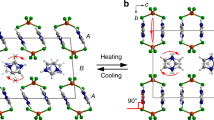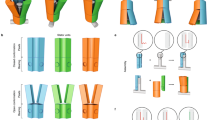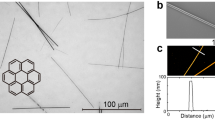Abstract
Many molecular machines with controllable molecular-scale motors have been developed. However, transmitting molecular movement to the macroscopic scale remains a formidable challenge. Here we report a single crystal of a Ni complex whose shape changes abruptly and reversibly in response to thermal changes at around room temperature. Variable-temperature single-crystal X-ray diffraction studies show that the crystalline shape change is induced by an unusual 90° rotation of uniaxially aligned oxalate molecules. The oxalate dianions behave as molecular-scale rotors, with their movement propagated through the entire crystalline material via intermolecular hydrogen bonding. Consequently, the subnanometre-scale changes in the oxalate molecules are instantly amplified to a micrometre-scale contraction or expansion of the crystal, accompanied by a thermal hysteresis loop. The shape change in the crystal was clearly detected under an optical microscope. The large directional deformation and prompt response suggest a role for this material in microscale or nanoscale thermal actuators.
This is a preview of subscription content, access via your institution
Access options
Subscribe to this journal
Receive 12 print issues and online access
$259.00 per year
only $21.58 per issue
Buy this article
- Purchase on Springer Link
- Instant access to full article PDF
Prices may be subject to local taxes which are calculated during checkout



Similar content being viewed by others
References
Kobatake, S., Takami, S., Muto, H., Ishikawa, T. & Irie, M. Rapid and reversible shape changes of molecular crystals on photoirradiation. Nature 446, 778–781 (2007).
Yu, Y. L., Nakano, M. & Ikeda, T. Directed bending of a polymer film by light. Nature 425, 145–145 (2003).
Hosono, N. et al. Large-area three-dimensional molecular ordering of a polymer brush by one-step processing. Science 330, 808–811 (2010).
Ma, M. M., Guo, L., Anderson, D. G. & Langer, R. Bio-inspired polymer composite actuator and generator driven by water gradients. Science 339, 186–189 (2013).
Kay, E. R., Leigh, D. A. & Zerbetto, F. Synthetic molecular motors and mechanical machines. Angew. Chem. Int. Ed. 46, 72–191 (2007).
Badjic, J. D., Balzani, V., Credi, A., Silvi, S. & Stoddart, J. F. A molecular elevator. Science 303, 1845–1849 (2004).
Coskun, A., Banaszak, M., Astumian, R. D., Stoddart, J. F. & Grzybowski, B. A. Great expectations: can artificial molecular machines deliver on their promise? Chem. Soc. Rev. 41, 19–30 (2012).
Bruns, C. J. & Stoddart, J. F. Molecular machines muscle up. Nature Nanotech. 8, 9–10 (2013).
Browne, W. R. & Feringa, B. L. Making molecular machines work. Nature Nanotech. 1, 25–35 (2006).
Vogelsberg, C. S. & Garcia-Garibay, M. A. Crystalline molecular machines: function, phase order, dimensionality, and composition. Chem. Soc. Rev. 41, 1892–1910 (2012).
Du, G. Y., Moulin, E., Jouault, N., Buhler, E. & Giuseppone, N. Muscle-like supramolecular polymers: integrated motion from thousands of molecular machines. Angew. Chem. Int. Ed. 51, 12504–12508 (2012).
Iamsaard, S. et al. Conversion of light into macroscopic helical motion. Nature Chem. 6, 229–235 (2014).
Garcia-Garibay, M. A. Molecular crystals on the move: from single-crystal-to-single-crystal photoreactions to molecular machinery. Angew. Chem. Int. Ed. 46, 8945–8947 (2007).
Goodwin, A. L. Organic crystals: packing down. Nature Mater. 9, 7–8 (2010).
Das, D., Jacobs, T. & Barbour, L. J. Exceptionally large positive and negative anisotropic thermal expansion of an organic crystalline material. Nature Mater. 9, 36–39 (2010).
Vukotic, V. N., Harris, K. J., Zhu, K., Schurko, R. W. & Loeb, S. J. Metal–organic frameworks with dynamic interlocked components. Nature Chem. 4, 456–460 (2012).
Nath, N. K., Panda, M. K., Sahoo, S. C. & Naumov, P. Thermally induced and photoinduced mechanical effects in molecular single crystals—a revival. CrystEngComm 16, 1850–1858 (2014).
Zhou, H. L. et al. Direct visualization of a guest-triggered crystal deformation based on a flexible ultramicroporous framework. Nature Commun. 4, 2534 (2013).
Lange, C. W. et al. Photomechanical properties of rhodium(I)–semiquinone complexes. The structure, spectroscopy, and magnetism of (3,6-di-tert-butyl-1,2-semiquinonato)dicarbonylrhodium(I). J. Am. Chem. Soc. 114, 4220–4222 (1992).
Irie, M. Photochromism and molecular mechanical devices. Bull. Chem. Soc. Jpn 81, 917–926 (2008).
Sokolov, A. N., Swenson, D. C. & MacGillivray, L. R. Conformational polymorphism in a heteromolecular single crystal leads to concerted movement akin to collective rack-and-pinion gears at the molecular level. Proc. Natl Acad. Sci. USA 105, 1794–1797 (2008).
Hayami, S., Gu, Z. Z., Yoshiki, H., Fujishima, A. & Sato, O. Iron(III) spin-crossover compounds with a wide apparent thermal hysteresis around room temperature. J. Am. Chem. Soc. 123, 11644–11650 (2001).
Padmanabhan, M., Joseph, J. C., Huang, X. & Li, J. Diamine incorporated compounds derived from polymeric nickel(II) fumarates and oxalates: crystal structure, spectral and thermal properties of [Ni(en)3](O2CCHCHCO2)·3H2O and [Ni(en)3](O2CCO2). J. Mol. Struct. 885, 36–44 (2008).
Fortes, A. D., Suard, E. & Knight, K. S. Negative linear compressibility and massive anisotropic thermal expansion in methanol monohydrate. Science 331, 742–746 (2011).
Goodwin, A. L. et al. Colossal positive and negative thermal expansion in the framework material Ag3[Co(CN)6]. Science 319, 794–797 (2008).
Shen, X., Viney, C., Johnson, E. R., Wang, C. & Lu, J. Q. Large negative thermal expansion of a polymer driven by a submolecular conformational change. Nature Chem. 5, 1035–1041 (2013).
Wu, Y. et al. Negative thermal expansion in the metal–organic framework material Cu3(1,3,5-benzenetricarboxylate)2 . Angew. Chem. Int. Ed. 47, 8929–8932 (2008).
Goodwin, A. L., Chapman, K. W. & Kepert, C. J. Guest-dependent negative thermal expansion in nanoporous Prussian blue analogues MIIPtIV(CN)6·x{H2O} (0 ≤ x ≤ 2; M = Zn, Cd). J. Am. Chem. Soc. 127, 17980–17981 (2005).
Margadonna, S., Prassides, K. & Fitch, A. N. Zero thermal expansion in a Prussian blue analogue. J. Am. Chem. Soc. 126, 15390–15391 (2004).
Birkedal, H., Schwarzenbach, D. & Pattison, P. Observation of uniaxial negative thermal expansion in an organic crystal. Angew. Chem. Int. Ed. 41, 754–756 (2002).
Horike, S., Shimomura, S. & Kitagawa, S. Soft porous crystals. Nature Chem. 1, 695–704 (2009).
Chen, C. L., Goforth, A. M., Smith, M. D., Su, C. Y. & zur Loye, H. C. [Co2(ppca)2(H2O)(V4O12)0.5]: a framework material exhibiting reversible shrinkage and expansion through a single-crystal-to-single-crystal transformation involving a change in the cobalt coordination environment. Angew. Chem. Int. Ed. 44, 6673–6677 (2005).
van Delden, R. A., Koumura, N., Harada, N. & Feringa, B. L. Unidirectional rotary motion in a liquid crystalline environment: color tuning by a molecular motor. Proc. Natl Acad. Sci. USA 99, 4945–4949 (2002).
Eelkema, R. et al. Nanomotor rotates microscale objects. Nature 440, 163–163 (2006).
Steiner, T. The hydrogen bond in the solid state. Angew. Chem. Int. Ed. 41, 48–76 (2002).
Kume, Y., Miyazaki, Y., Matsuo, T. & Suga, H. Low temperature heat capacities of ammonium hexachlorotellurate and its deuterated analog. J. Phys. Chem. Solids 53, 1297–1304 (1992).
Ichikawa, M. & Matsuo, T. Deuteration-induced structural phase transitions in some hydrogen-bonded crystals. J. Mol. Struct. 378, 17–27 (1996).
Acknowledgements
This work was supported by a KAKEN on Innovative Areas (‘Soft Molecular Systems’ Area 2503, No. 26104528) from MEXT (Japan). Z-S.Y. thanks the China Scholarship Council for support.
Author information
Authors and Affiliations
Contributions
Z-S.Y. and O.S. designed the study, conducted experiments and wrote most of the paper. M.M. and S. Kang assisted in measuring the change in crystal shape. K.T., K.Z. and S. Kanegawa contributed to the diffraction studies. T.K., Y.S. and K.Y. performed the calculations and wrote the related discussion. N.A. and Y.M. performed the heat-capacity measurements. T.N. contributed to analyses of the molecular motion. All authors discussed the results and commented on the manuscript.
Corresponding author
Ethics declarations
Competing interests
The authors declare no competing financial interests.
Supplementary information
Supplementary information
Supplementary information (PDF 5509 kb)
Supplementary video
Supplementary video 1 (MOV 575 kb)
Supplementary video
Supplementary video 2 (MOV 445 kb)
Supplementary information
Crystallographic data for compound 1 at 243 K, LT phase. (CIF 283 kb)
Supplementary information
Crystallographic data for compound 1 at 263 K, HT phase. (CIF 77 kb)
Supplementary information
Crystallographic data for compound 1 at 263 K, LT phase. (CIF 281 kb)
Supplementary information
Crystallographic data for compound 1 at 283 K, HT phase. (CIF 137 kb)
Supplementary information
Crystallographic data for compound 2 at 223 K, LT phase. (CIF 322 kb)
Supplementary information
Crystallographic data for compound 2 at 293 K, HT phase. (CIF 103 kb)
Supplementary information
Crystallographic data for compound 3 at 200 K, LT phase. (CIF 634 kb)
Supplementary information
Crystallographic data for compound 3 at 288 K, HT phase. (CIF 130 kb)
Rights and permissions
About this article
Cite this article
Yao, ZS., Mito, M., Kamachi, T. et al. Molecular motor-driven abrupt anisotropic shape change in a single crystal of a Ni complex. Nature Chem 6, 1079–1083 (2014). https://doi.org/10.1038/nchem.2092
Received:
Accepted:
Published:
Issue Date:
DOI: https://doi.org/10.1038/nchem.2092
This article is cited by
-
Photothermally induced natural vibration for versatile and high-speed actuation of crystals
Nature Communications (2023)
-
Near-room-temperature martensitic actuation profited from one-dimensional hybrid perovskite structure
Nature Communications (2022)
-
Giant single-crystal-to-single-crystal transformations associated with chiral interconversion induced by elimination of chelating ligands
Nature Communications (2021)
-
A theoretical investigation into the cooperativity effect on the TNT melting point under external electric field
Journal of Molecular Modeling (2021)
-
Towards artificial molecular factories from framework-embedded molecular machines
Nature Reviews Chemistry (2020)



